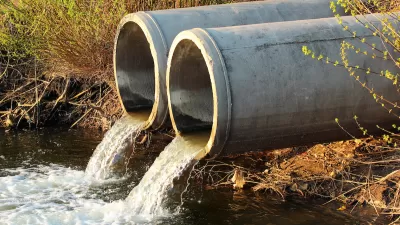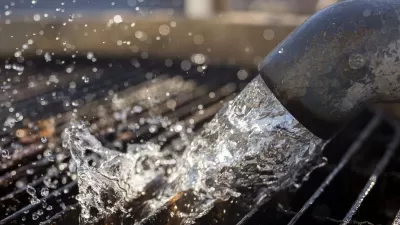The raw and partially treated sewage that has for the past month, and continues to, flow into the New York region's waterways "will be one of the most enduring and expensive effects of Hurricane Sandy," reports Michael Schwirtz.
New York has suffered from the occasional storm related sewage release for decades, but the hundreds of millions of gallons of raw and partially treated sewage that has flowed into waterways in New York and New Jersey over the past month is unprecedented. As bad as that deluge sounds, and smells, the long-term impacts are far more concerning. As Schwirtz notes, "[a]lmost all [sewage treatment] facilities in the region are situated close to sea level and are vulnerable to storm surges," and repairing and protecting the area's wastewater infrastructure "could take several years and billions of dollars."
"In New York alone," says Schwirtz, "Gov. Andrew M. Cuomo has estimated that about $1.1 billion will be needed just for repairs to treatment plants. But officials now acknowledge that they will have to do far more. Motors and electrical equipment must be raised above new flood levels, and circuitry must be made waterproof. Dams and levees may have to be built at some treatment plants to keep the rising waters at bay, experts say. Failure to do so could leave large swaths of the population vulnerable to public health and environmental hazards in future storms, experts said."
“'You’re looking at significant expenditures of money to make the plants more secure,' said John Cameron, an engineer specializing in wastewater treatment facilities who is chairman of the Long Island Regional Planning Council. 'There is no Band-Aid for this,' Mr. Cameron said. 'This is the new normal.'”
h/t to Daniel Lippman
FULL STORY: Sewage Flows After Storm Exposes Flaws in System

Study: Maui’s Plan to Convert Vacation Rentals to Long-Term Housing Could Cause Nearly $1 Billion Economic Loss
The plan would reduce visitor accommodation by 25,% resulting in 1,900 jobs lost.

North Texas Transit Leaders Tout Benefits of TOD for Growing Region
At a summit focused on transit-oriented development, policymakers discussed how North Texas’ expanded light rail system can serve as a tool for economic growth.

Why Should We Subsidize Public Transportation?
Many public transit agencies face financial stress due to rising costs, declining fare revenue, and declining subsidies. Transit advocates must provide a strong business case for increasing public transit funding.

How to Make US Trains Faster
Changes to boarding platforms and a switch to electric trains could improve U.S. passenger rail service without the added cost of high-speed rail.

Columbia’s Revitalized ‘Loop’ Is a Hub for Local Entrepreneurs
A focus on small businesses is helping a commercial corridor in Columbia, Missouri thrive.

Invasive Insect Threatens Minnesota’s Ash Forests
The Emerald Ash Borer is a rapidly spreading invasive pest threatening Minnesota’s ash trees, and homeowners are encouraged to plant diverse replacement species, avoid moving ash firewood, and monitor for signs of infestation.
Urban Design for Planners 1: Software Tools
This six-course series explores essential urban design concepts using open source software and equips planners with the tools they need to participate fully in the urban design process.
Planning for Universal Design
Learn the tools for implementing Universal Design in planning regulations.
City of Santa Clarita
Ascent Environmental
Institute for Housing and Urban Development Studies (IHS)
City of Grandview
Harvard GSD Executive Education
Toledo-Lucas County Plan Commissions
Salt Lake City
NYU Wagner Graduate School of Public Service




























